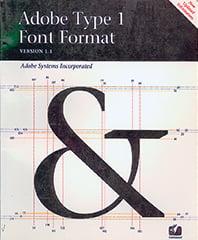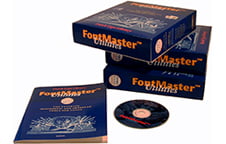see dtl’s ExquisiteFonts website!
| Home | Search | Site index | About | Contact |
OpenType versions of the dtl fonts are available from the OpenType Boutique. Information about upgrading ps Type1 and TrueType licenses to the OpenType format can be found on the OpenType Upgrade Program web page.
In the mid-1980s the first scalable font formats appeared, including urw’s vs and bs (Vector and Bézier formats with instructions), Adobe’s PostScript Type1, Sun Microsystems’ f3 (Folio-Font-Format) and Bitstream’s Speedo formats. Before that, there were proprietary hardware-dependent bitmap and vector font formats. In addition to a scalable resolution-independent contour description, the Type1 format also contained hints, i.e., instructions to control the rasterization at relatively low resolutions. In the late 1980s, Apple developed the TrueType format, which was based on Unicode and could contain even more detailed hints, called ‘delta hints’. The TrueType format was also more flexible and extensible than, for example, Type1.
The TrueType format was implemented in Mac OS in 1990 and in Windows 3.1 a year later. In the years that followed, the single-byte Type1 format was opened to support double-byte encodings. The cid font format for cjk appeared in 1993. In 1994, the TrueType gx format, which supported advanced layout features for glyph substitution and positioning, as is now part of OpenType fonts, came on the market. However, it failed due to a lack of support by applications. In 1995, the specification for Microsoft’s TrueType Open (tto) format, which later evolved into OpenType, saw the light of day, as well as the TrueType Collection (ttc) format. A year later, Adobe joined Microsoft in developing the tto format. In 1997, the OpenType specification was published.
Apple did not participate in the development of the OpenType format: instead, it focused on the Apple Advanced Typography (aat) format, a renamed version of the gx format. Then, until Mac os 10.4 (Tiger), there was no operating-system level support for the OpenType Layout features. In Tiger there was partial support via internal conversion to aat tables.
For the OpenType format, this basically meant that to work properly on both macOS and Windows, the fonts had to support both OpenType Layout tables and aat tables. In Adobe applications, the support of the ot layout features is built into the programs such as InDesign, PhotoShop, and Illustrator, so these apps are cross-platform when it comes to handling fonts. The support for the OpenType format under Linux comes from Freetype.
OpenType is more than a simple font format; it is an architecture with building blocks. First, there is the font, second, the operating system support, third, the application-level support, and finally, printer support. OpenType fonts have four essential ingredients: the outline description (Bézier and/or quadratic splines), the hinting information, the character-mapping tables, and the ot layout features.

Adobe introduced the PostScript Type1 format in the mid-1980s
Through gsub features, all kinds of substitutions can be made in OpenType fonts
This OpenType Layout features code ensures that the fi-ligature is excluded for Turkish
OpenType fonts come in two varieties, namely Compact Font Format (cff) with PostScript Type1-like outlines and hints, and TrueType Font (ttf), which contains quadratic splines and can optionally contain high-quality TrueType hinting instructions. Normally, the different versions can be identified by their suffix: ‘.otf’ for cff and ‘.ttf’ for the TrueType flavor. Technically, the .otf suffix can also be used for the TrueType-flavored OpenType fonts, but this is not standard practice.
Basically OpenType is the TrueType format plus some additional tables that allow access to glyphs that do not have a direct Unicode code point, and character reordering and/or glyph processing, to handle, for example, complex scripts like Arabic and Indic. OpenType fonts make it possible to implement sophisticated mappings between characters and glyphs to support ligatures, positional shapes, alternatives, and other substitutions. Furthermore, OpenType fonts can contain explicit script and language information and the format, as the name implies, is open, i.e., font developers can define their own typographical attributes.
There is no standard when it comes to the number of glyphs an OpenType font can contain. In principle, the number of characters can be a single byte (256) to a double byte (65536). An OpenType font can contain one or more scripts, such as Latin, Cyrillic, Greek, or cjk.
A script is a large collection of characters needed to support one or more writing systems. Writing system is an orthographic term for a set of rules for a language. In typography, this results in a subset of characters to represent the language in question. For example, the Latin script forms the basis for the Dutch, German, French, Italian, etc., languages and related writing systems. The script cjk includes, among others, the writing systems used in Japan, namely Hiragana, Katakana, and Kanji.
The implemented layout functions can be hundreds or none. The standard may vary by font manufacturer or even within a particular font collection. The different content and layout features sometimes make it difficult for end users to estimate and understand what an OpenType font exactly contains.
Especially with OpenType font production in mind, more than 20 years ago the Dutch Type Library developed the dtl FontMaster (fm) suite, a set of modules for professional font production. The OpenType support in fm is built on the Adobe Software Development Kit for OpenType and it was the first application (and currently still the only one) to smartly automate the generation of gsub and gpos features. This ensures technical consistency and uniformity in all OpenType fonts produced by the Dutch Type Library.
In the spring of 2009, dtl OTMaster, an advanced OpenType (table) editor, was released and the current successor to dtl FontMaster for macOS, Windows, and Linux is dtl FoundryMaster.
The Dutch Type Library’s OpenType fonts come in three flavors: Standard, Pro, and Plus. The OpenType Standard fonts contain single-byte code pages, and with the exception of the small-caps versions, these fonts contain both tabular and old-style figures. Therefore, OpenType Standard fonts are the equivalents of the ‘Standard’ and ‘Special’ dtl fonts in the ps Type1 and ‘plain’ TrueType formats. Switching between the two sets of figures is possible via an OpenType Layout feature.
The OpenType Pro fonts contain character sets for all Western, Central and Eastern European languages, and Turkish, as well as for the relevant small caps. The tabular and old-style figures are available in both tabular and proportional widths. Also an extensive range of ligatures, superior and inferior figures, (nut) fractions, etc., with appropriate OpenType Layout features are part of the Pro versions. The OpenType Plus fonts contain Cyrillic and/or Greek code pages in addition to the character set of the Pro versions.
Adobe InDesign supported OpenType layout features early on

The dtl FontMaster suite
Search | Site index | Contact | Terms of use | Trademarks | Acknowledgements
Last update: 18 November 2024. Copyright © Dutch Type Library, 1998–2024. All rights reserved
dtl Headquarters | Zwaenenstede 49 | 5221 kc ’s-Hertogenbosch | The Netherlands
dtl Studio | Daliënwaerd 71 | 5221 ke ’s-Hertogenbosch | The Netherlands
phone: +31 (0)73 614 95 36 | fax: +31 (0)73 613 98 23 | e-mail: info@dutchtypelibrary.com